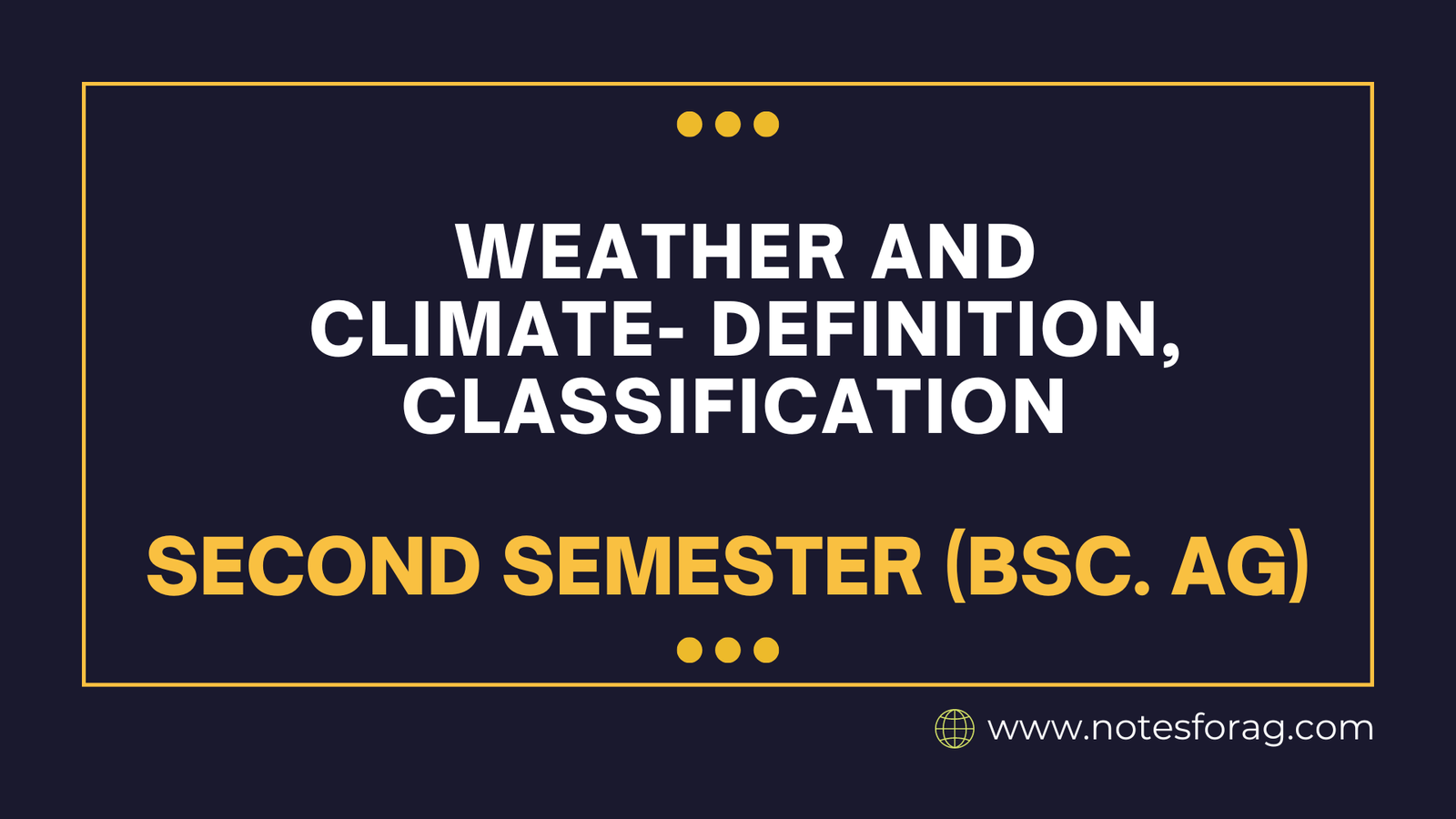Weather and Climate is critical for good planning and management in industries including agriculture, environmental science, and urban development. Weather describes the short-term atmospheric conditions in a certain location at a specific moment, which include factors such as temperature, humidity, precipitation, and wind. Climate, on the other hand, refers to the long-term average of weather patterns in a certain location over a period of time, usually 30 years or longer. Weather is defined based on immediate conditions such as hot, cold, rainy, or windy, whereas climate is classified using systems such as the Köppen Climate Classification, which divides climates into tropical, dry, temperate, continental, or polar.
Table of Contents
Definitions

1. Weather:
- Definition: Weather describes the short-term atmospheric conditions in a certain location at a specific moment. It comprises temperature, humidity, precipitation, wind speed and direction, and cloud cover. Weather can change by the minute, hour, day, or season.
- Example: A sunny day with temperatures about 25°C, light winds, and no precipitation.
2. Climate:
- Definition: Climate is defined as the long-term average of weather conditions and patterns in a given location over a large period of time, usually 30 years or more. It covers the statistical analysis of meteorological data, such as the frequency, intensity, and duration of various weather occurrences.
- Example: The Mediterranean climate features hot, dry summers and warm, wet winters.
Components and Variables of Weather
Weather is a complicated interplay of numerous atmospheric components and variables, all of which play an important role in defining the circumstances we face on a daily basis. Temperature, humidity, precipitation, wind speed and direction, and air pressure are the five main components of weather. Understanding these factors is critical for proper weather forecasting and public safety.
Temperature is a measure of the warmth or coldness of the atmosphere, usually expressed in degrees Celsius (°C) or Fahrenheit. Temperature is measured with thermometers, which might be classic mercury or modern digital. Temperature variations are caused by solar radiation and can result in phenomena such as heatwaves and cold spells.
Humidity, expressed as a percentage, denotes the amount of water vapor in the air. Hygrometers monitor humidity levels, and more humidity can make temperatures appear warmer than they actually are. Humidity plays an important influence in weather patterns, causing clouds and precipitation.
Precipitation refers to all liquid or solid water that falls from clouds to the Earth’s surface, including rain, snow, sleet, and hail. Rain gauges determine the volume of precipitation, whereas radar devices monitor its intensity and velocity. Precipitation is necessary for water supplies, but excessive amounts can cause flooding and other problems.
Wind speed and direction are measured with anemometers and wind vanes. Wind has a strong influence on temperature distribution and the movement of weather fronts. Strong winds can cause severe storms and alter different meteorological phenomena.
Atmospheric pressure is the force exerted by the weight of the air above us, which is measured via barometers in millibars (mb) or inches of mercury (inHg). Changes in atmospheric pressure indicate weather changes, such as the arrival of a high-pressure system providing fair weather or a low-pressure system causing storms.
Climate Classification Systems
Climate classification systems are critical tools that scientists use to describe and comprehend the various climate types found around the globe. Among these systems, the Köppen Climate Classification System is one of the most extensively used frameworks. Wladimir Köppen developed this concept in the early twentieth century, and it uses particular criteria, chiefly temperature and precipitation patterns, to discriminate between distinct climate zones.
1. Köppen Climate Classification:
- A. Tropical climates: High temperatures throughout year, with plenty of precipitation.
- Example: Tropical Rainforest (AF), Tropical Monsoon (AM), and Tropical Savanna (AW).
- B: Dry climates: Low precipitation and considerable evaporation.
- Example: Desert (BWh, BWk); steppe (BSh, BSk).
- C: temperate climates: Moderate temperatures and different seasons.
- Example: Humid subtropical (Cfa, Cwa), Mediterranean (Csa, Csb), and Marine West Coast (Cfb, Cfc).
- D: Continental climates: Temperatures vary greatly, with chilly winters and pleasant summer months.
- Example: Humid continental (Dfa, Dfb, Dwa, Dwb); subarctic (Dfc, Dfd, Dwc, Dwd).
- E: Polar climates: Temperatures are extremely chilly throughout the year.
- Example: Tundra (ET); Ice Cap (EF).
2. Thornthwaite Climate Classification:
- Climates are classified based on potential evapotranspiration.
- Megathermal: High temperature and humidity.
- Mesothermal: Moderate temps and humidity.
- Microthermal: Cold temps and moderate precipitation.
- Polar: Extremely cold with very little precipitation.
3. Holdridge Life Zones:
- Depends on biotemperature, precipitation, and humidity.
- Climates are classified into zones such as tropical rainforest, tropical dry forest, and temperate rainforest.
Impact of Climate Change on Weather Patterns
Climate change, mostly caused by human activities such as greenhouse gas emissions, is dramatically altering the Earth’s climate. The relationship between weather and climate patterns is complex, but the evidence for its impact is clear. One of the most obvious markers of climate change is the constant rise in global temperatures. Scientific studies reveal that the average global temperature has risen by around 1.2 degrees Celsius since the late nineteenth century, owing primarily to higher quantities of carbon dioxide and other greenhouse gases in the atmosphere.
In addition to rising temperatures, additional indicators of climate change include rapid melting of polar ice caps and glaciers. This melting adds to increasing sea levels, threatening coastal populations around the world. Furthermore, the number and severity of extreme weather occurrences have grown. For example, hurricanes and typhoons are becoming more powerful, wreaking havoc on human populations and natural ecosystems.
The effects of these shifts in weather and climate patterns are profound. More severe storms can cause widespread damage to infrastructure and loss of life. Longer and more severe droughts have an impact on water availability, agriculture, and food security, whereas altered precipitation patterns can result in unpredictable and often catastrophic weather conditions, complicating efforts to manage water resources and agricultural planning.
Addressing the effects of weather and climate change patterns necessitates a diverse strategy. Global efforts to counteract climate change are critical to lowering greenhouse gas emissions. This includes enacting regulations that encourage the use of renewable energy sources, energy efficiency, and sustainable land use practices. Technological innovations also play an important role in finding novel solutions to reduce emissions and adapt to changing weather and climate circumstances.
Weather and Climate are fundamental concepts that describe atmospheric conditions over different timescales. Weather and climate, while linked, refer to various characteristics of atmospheric circumstances. Weather is the short-term state of the atmosphere at a certain location and time, including elements such as temperature, humidity, precipitation, and wind, which can vary quickly. Climate, on the other hand, refers to the long-term average of weather patterns in a certain place over a period of 30 years or more. It entails doing statistical analyses of meteorological data to find typical ranges, variances, and trends. Understanding weather and climate principles is critical for making sound judgments in agriculture, urban planning, and natural resource management.
Frequently Asked Question(FAQ)
What is the difference between weather and climate?
The distinction between weather and climate is the timeline and extent of the atmospheric conditions they describe. Weather refers to the short-term characteristics of the atmosphere at a certain time and location, which include elements like temperature, humidity, precipitation, and wind. Climate, on the other hand, is the long-term average of weather patterns in a certain location over a period of time, usually 30 years or more.
How does climate change impact weather patterns?
Climate change has the potential to increase the frequency and intensity of extreme weather events such as heatwaves, storms, droughts, and heavy rains. It affects long-term climatic averages and increases variability.
Related Articles

